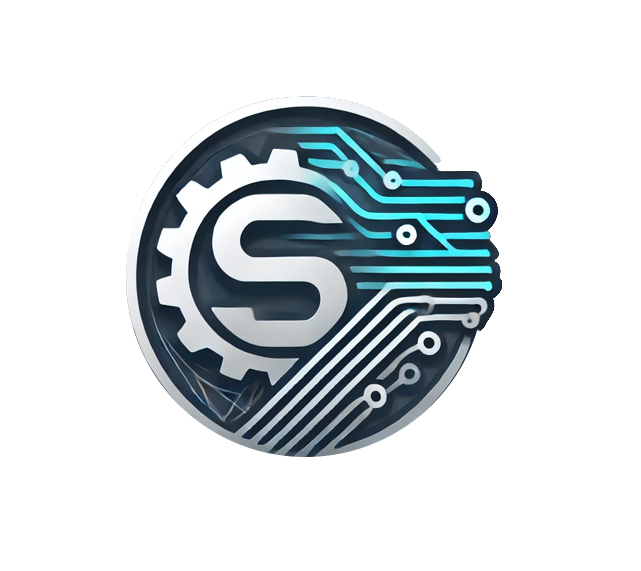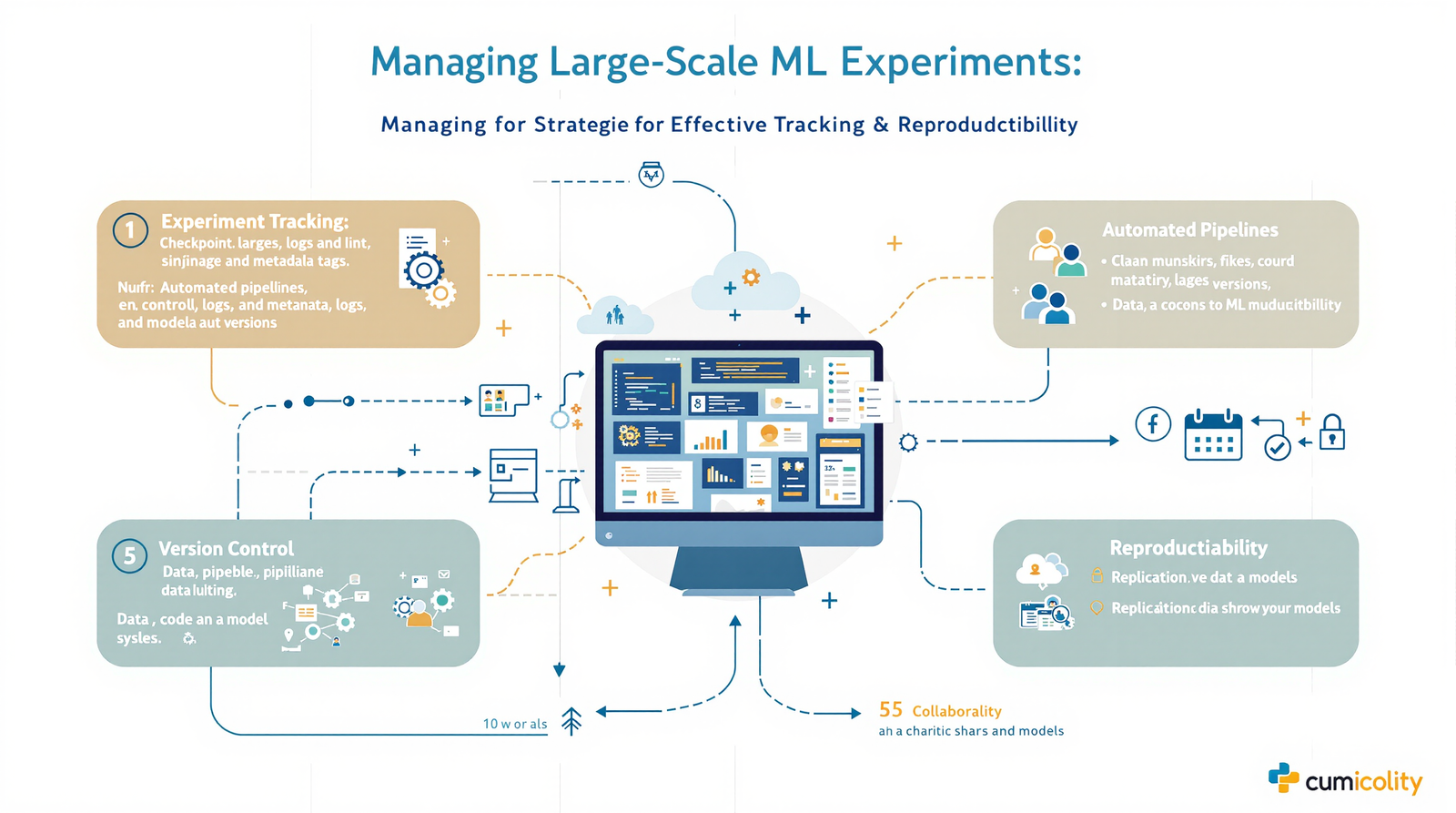Introduction: The Importance of Experiment Management in ML
In the rapidly evolving field of machine learning, managing experiments effectively is crucial for driving innovation, ensuring reproducibility, and accelerating the development of high-quality models. As organizations scale their AI initiatives, the number of experiments—each with different data versions, model architectures, hyperparameters, and evaluation metrics—can grow exponentially. Without proper experiment management, teams risk losing track of their work, duplicating efforts, and making decisions based on incomplete or inconsistent information.
Experiment management encompasses the processes and tools used to organize, track, and reproduce machine learning experiments. It provides a structured framework that captures all relevant metadata, including code versions, data snapshots, model parameters, training configurations, and performance metrics. This comprehensive tracking enables data scientists and engineers to compare results systematically, identify the best-performing models, and understand the impact of different variables on model outcomes.
Beyond improving productivity, effective experiment management is essential for collaboration. It allows teams to share insights, review each other’s work, and build upon previous experiments without starting from scratch. This transparency fosters a culture of continuous learning and innovation.
Reproducibility is another critical benefit. In regulated industries or high-stakes applications, being able to reproduce model training and evaluation is necessary for compliance, auditing, and trust. Experiment management ensures that every model version can be traced back to its exact training conditions, facilitating debugging and validation.
In summary, managing machine learning experiments at scale is foundational to successful AI development. By implementing robust experiment tracking and management practices, organizations can enhance collaboration, ensure reproducibility, and accelerate the delivery of impactful machine learning solutions.
Challenges of Managing Large-Scale ML Experiments
Managing machine learning experiments at a large scale presents a unique set of challenges that can hinder productivity, compromise reproducibility, and slow down the path to production. As organizations move beyond single-model projects to complex AI initiatives, these challenges become increasingly pronounced.
- Proliferation of Experiments and Artifacts:
Data scientists often run hundreds or thousands of experiments, each generating numerous model artifacts, logs, and metrics. Without a centralized system, tracking these disparate results becomes overwhelming, leading to lost information and duplicated efforts.
- Reproducibility Crisis:
Reproducing past experiments is notoriously difficult in ML. Changes in code, data versions, library dependencies, or even random seeds can lead to different results. Ensuring that an experiment can be precisely recreated is a major hurdle.
- Lack of Standardization:
Different team members may use varying approaches for logging metrics, storing models, or naming experiments. This lack of standardization makes it hard to compare results consistently or integrate models into production pipelines.
- Data Versioning Complexity:
ML models are highly sensitive to data. Managing and linking specific data versions to each experiment run is complex, especially with large, evolving datasets. Data drift can further complicate reproducibility.
- Collaboration Overhead:
When multiple data scientists work on the same problem, sharing experiment results, understanding each other’s configurations, and avoiding redundant work can be challenging without a shared platform.
- Resource Management:
Large-scale experimentation consumes significant compute resources. Tracking resource usage per experiment and optimizing allocation across concurrent runs is a non-trivial task.
- Debugging and Root Cause Analysis:
When a model underperforms, identifying whether the issue stems from data, code, hyperparameters, or the training environment requires detailed experiment logs and traceability.
Key Components of Effective Experiment Tracking
Effective experiment tracking is essential for managing the complexity of machine learning development, especially at scale. It provides the foundation for reproducibility, collaboration, and informed decision-making. Here are the key components that constitute a robust experiment tracking system:
- Comprehensive Metadata Capture
Every experiment should record detailed metadata, including code versions, data snapshots, hyperparameters, model architectures, training configurations, and evaluation metrics. This metadata enables teams to understand the context of each experiment and compare results accurately.
- Version Control Integration
Linking experiments to specific versions of code and data ensures that results are reproducible. Integration with version control systems like Git, along with data versioning tools such as DVC or LakeFS, helps maintain this linkage seamlessly.
- Centralized Storage of Artifacts
Models, logs, plots, and other artifacts generated during experiments should be stored in a centralized, accessible repository. This facilitates sharing, auditing, and reuse across teams.
- Experiment Organization and Naming Conventions
A clear structure for organizing experiments—using consistent naming conventions, tags, and grouping—makes it easier to search, filter, and analyze results, especially when dealing with large numbers of experiments.
- Visualization and Comparison Tools
Interactive dashboards and visualization tools allow users to compare experiment metrics, visualize training curves, and identify trends or anomalies. This accelerates model selection and tuning.
- Access Control and Collaboration Features
Role-based access control and collaboration tools enable secure sharing of experiments and results among team members, fostering transparency and collective learning.
- Integration with MLOps Pipelines
Experiment tracking should be integrated with CI/CD pipelines, model registries, and monitoring systems to create a seamless workflow from development to deployment and maintenance.
Tools and Platforms for Experiment Management
Managing machine learning experiments effectively requires robust tools and platforms that can handle the complexity and scale of modern AI projects. These tools provide essential capabilities such as experiment tracking, versioning, collaboration, and reproducibility, enabling teams to streamline their workflows and accelerate innovation.
Why Use Experiment Management Tools?
Machine learning experimentation involves testing numerous model configurations, datasets, and training parameters. Without proper management, it’s easy to lose track of what was tried, which models performed best, and how results were obtained. Experiment management tools centralize this information, making it accessible and actionable for data scientists, engineers, and stakeholders.
Popular Experiment Management Platforms
MLflow:
An open-source platform that offers experiment tracking, model registry, and deployment tools. MLflow allows users to log parameters, metrics, and artifacts, compare runs, and manage model versions. Its flexibility and integration with many ML frameworks make it a popular choice.
Weights & Biases (W&B):
A cloud-based platform focused on experiment tracking, visualization, and collaboration. W&B provides rich dashboards, hyperparameter tuning tools, and team collaboration features, helping organizations scale their ML efforts.
A metadata store for ML experiments that supports tracking, visualization, and collaboration. Neptune integrates with popular ML libraries and offers flexible logging and reporting capabilities.
Provides experiment tracking, model management, and collaboration tools. Comet supports real-time monitoring and integrates with many ML frameworks and cloud platforms.
DVC (Data Version Control):
While primarily a data and model versioning tool, DVC also supports experiment tracking by linking data, code, and model versions, enabling reproducibility.
Choosing the Right Tool
Selecting an experiment management platform depends on factors such as team size, project complexity, preferred ML frameworks, and integration needs. Open-source tools like MLflow and DVC offer flexibility and control, while cloud-based platforms like W&B and Neptune provide ease of use and collaboration features.
Integration with MLOps
Experiment management tools are most effective when integrated into broader MLOps pipelines. They should work seamlessly with CI/CD systems, model registries, data versioning tools, and monitoring platforms to provide end-to-end visibility and automation.
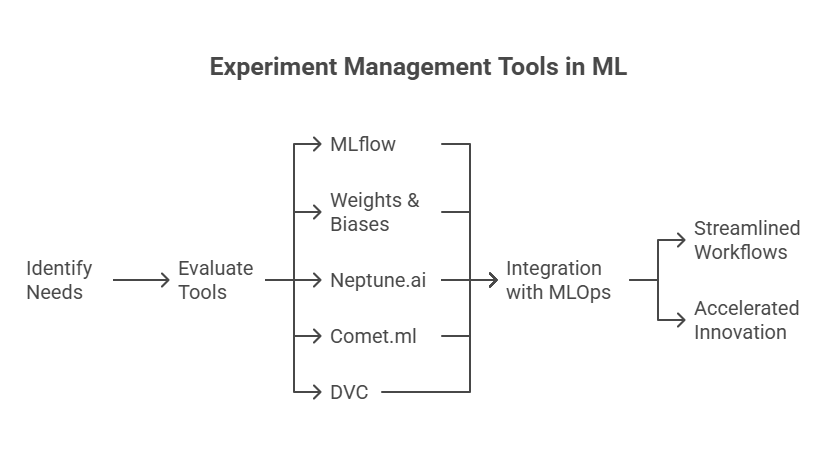
Best Practices for Organizing and Naming Experiments
Organizing and naming machine learning experiments effectively is a crucial yet often overlooked aspect of experiment management. As the number of experiments grows, especially in large teams or enterprise settings, a clear and consistent structure helps maintain order, facilitates collaboration, and accelerates the discovery of valuable insights.
Why Organization and Naming Matter
Without a standardized approach, experiment records can become chaotic, making it difficult to locate specific runs, compare results, or understand the context of an experiment. This can lead to duplicated efforts, misinterpretation of results, and slower development cycles.
Best Practices for Organizing Experiments
Use Hierarchical Grouping:
Organize experiments into projects, folders, or tags based on business units, use cases, or model types. This structure helps teams navigate large experiment repositories efficiently.
Consistent Naming Conventions:
Develop clear, descriptive naming schemes that include key information such as model type, dataset version, feature set, or experiment purpose. For example: fraud_detection_v2_featureSetA_2024-06-30.
Include Metadata and Tags:
Use metadata fields and tags to capture additional context like hyperparameters, training environment, or experiment status. This enhances searchability and filtering.
Version Control Integration:
Link experiment names or IDs to specific code commits or data versions to ensure traceability.
Document Experiment Objectives:
Maintain brief descriptions or notes explaining the goal of each experiment, assumptions made, and any deviations from standard procedures.
Automate Naming and Logging:
Use experiment management tools that support automated naming based on parameters or timestamps to reduce manual errors.
Benefits of Structured Organization
Improved Collaboration: Teams can easily find and understand each other’s work.
Faster Analysis: Clear naming and grouping speed up comparison and selection of best models.
Enhanced Reproducibility: Linking names to versions and metadata supports reliable experiment reproduction.
Reduced Errors: Consistency minimizes confusion and mistakes in managing experiments.
Automating Experiment Logging and Metadata Capture
Automating experiment logging and metadata capture is a vital practice in managing machine learning workflows efficiently. It ensures that every experiment’s parameters, metrics, artifacts, and contextual information are systematically recorded without manual effort. This automation not only improves reproducibility and traceability but also accelerates collaboration and decision-making across data science and engineering teams.
Why Automate Logging and Metadata Capture?
Manual logging is error-prone and often incomplete, leading to difficulties in reproducing results or comparing experiments. Automated logging captures all relevant information consistently, enabling teams to track progress, analyze performance trends, and audit experiments for compliance.
What to Log Automatically?
Hyperparameters: Learning rates, batch sizes, model architectures, etc.
Training Metrics: Accuracy, loss, precision, recall, etc.
Data Versions: Information about datasets and feature versions used.
Model Artifacts: Serialized models, preprocessing pipelines, and other files.
Environment Details: Software versions, hardware specs, and runtime configurations.
Experiment Metadata: Timestamps, user info, experiment descriptions, and tags.
Tools for Automation
Many experiment tracking platforms like MLflow, Weights & Biases, and Neptune.ai provide APIs to automate logging. These tools integrate with popular ML frameworks and support rich metadata capture.
Example: Automated Experiment Logging with MLflow
Here’s a simple Python example demonstrating how to automate experiment logging using MLflow:
python
import mlflow
import mlflow.sklearn
from sklearn.ensemble import RandomForestClassifier
from sklearn.datasets import load_iris
from sklearn.model_selection import train_test_split
from sklearn.metrics import accuracy_score
# Load data
data = load_iris()
X_train, X_test, y_train, y_test = train_test_split(data.data, data.target, random_state=42)
# Start MLflow run
with mlflow.start_run():
# Define and train model
n_estimators = 100
max_depth = 5
model = RandomForestClassifier(n_estimators=n_estimators, max_depth=max_depth, random_state=42)
model.fit(X_train, y_train)
# Predict and evaluate
preds = model.predict(X_test)
accuracy = accuracy_score(y_test, preds)
# Log parameters and metrics
mlflow.log_param("n_estimators", n_estimators)
mlflow.log_param("max_depth", max_depth)
mlflow.log_metric("accuracy", accuracy)
# Log model artifact
mlflow.sklearn.log_model(model, "random_forest_model")
print(f"Logged experiment with accuracy: {accuracy:.4f}")Versioning Data, Code, and Models for Reproducibility
Versioning is a fundamental practice in MLOps that ensures reproducibility, traceability, and collaboration across machine learning projects. By systematically tracking changes to data, code, and models, teams can reliably reproduce experiments, debug issues, and maintain compliance with regulatory requirements.
Why Versioning Matters
Machine learning models are highly sensitive to the data and code used during training. Even minor changes in datasets, preprocessing steps, or model parameters can lead to different outcomes. Without proper versioning, it becomes challenging to understand which version of a model corresponds to which data and code, making debugging and auditing difficult.
Data Versioning
Data versioning tools like DVC (Data Version Control) and LakeFS enable teams to track changes in datasets similarly to how Git tracks code. This includes managing large files, handling data lineage, and enabling rollback to previous data versions. Data versioning ensures that models are trained on consistent and well-documented datasets.
Code Versioning
Using version control systems like Git is standard practice for managing code changes. Integrating code repositories with experiment tracking and model registries links code versions to specific model artifacts and training runs, enhancing reproducibility.
Model Versioning
Model registries such as MLflow Model Registry, SageMaker Model Registry, or Azure ML Model Registry provide centralized storage and versioning of trained models. They track metadata, performance metrics, and deployment status, enabling safe promotion, rollback, and auditability.
Example: Linking Code and Model Versions with MLflow
python
import mlflow
import mlflow.sklearn
from sklearn.ensemble import RandomForestClassifier
from sklearn.datasets import load_iris
from sklearn.model_selection import train_test_split
from sklearn.metrics import accuracy_score
import subprocess
# Get current Git commit hash
commit_hash = subprocess.check_output(["git", "rev-parse", "HEAD"]).decode("utf-8").strip()
# Load data
data = load_iris()
X_train, X_test, y_train, y_test = train_test_split(data.data, data.target, random_state=42)
with mlflow.start_run():
# Log Git commit hash
mlflow.set_tag("git_commit", commit_hash)
# Train model
model = RandomForestClassifier(n_estimators=100, random_state=42)
model.fit(X_train, y_train)
# Evaluate
preds = model.predict(X_test)
accuracy = accuracy_score(y_test, preds)
# Log parameters, metrics, and model
mlflow.log_param("n_estimators", 100)
mlflow.log_metric("accuracy", accuracy)
mlflow.sklearn.log_model(model, "model")
print(f"Logged model with accuracy: {accuracy:.4f} and commit: {commit_hash}")Automation and Orchestration: Tools and Frameworks
Automation and orchestration are the engines that drive efficient DataOps and MLOps workflows. By automating repetitive tasks and orchestrating complex dependencies across data and ML pipelines, organizations can accelerate delivery, reduce errors, and scale their operations effectively.
The Role of Automation
Automation in DataOps and MLOps eliminates manual intervention in routine tasks such as data ingestion, validation, transformation, model training, and deployment. This not only speeds up workflows but also ensures consistency and reduces the risk of human error. Automated pipelines can run on schedules, be triggered by events (like new data arrival), or respond to performance thresholds.
Orchestration: Managing Complex Workflows
Orchestration tools manage the execution order, dependencies, and resource allocation across multiple pipeline components. They ensure that data processing steps complete before model training begins, that validation passes before deployment, and that failures are handled gracefully with appropriate retries or rollbacks.
Popular Tools and Frameworks
Apache Airflow: A widely-used open-source platform for orchestrating complex workflows with rich scheduling, monitoring, and dependency management capabilities.
Kubeflow Pipelines: Designed specifically for ML workflows on Kubernetes, offering containerized, scalable pipeline execution.
Prefect: A modern workflow orchestration tool with dynamic task generation and robust error handling.
Cloud-native solutions: AWS Step Functions, Azure Data Factory, and Google Cloud Composer provide managed orchestration services.
Integration Benefits
When DataOps and MLOps share orchestration platforms, teams can create end-to-end workflows that seamlessly transition from data preparation to model deployment and monitoring. This unified approach enables better resource utilization, simplified monitoring, and faster troubleshooting.
Here’s a simple Python example using a basic orchestration pattern:
python
def orchestrate_pipeline():
"""Simple pipeline orchestration example"""
try:
# Step 1: Data validation
print("Step 1: Validating data...")
data_valid = validate_data()
if not data_valid:
raise Exception("Data validation failed")
# Step 2: Feature engineering
print("Step 2: Engineering features...")
features = engineer_features()
# Step 3: Model training
print("Step 3: Training model...")
model = train_model(features)
# Step 4: Model validation
print("Step 4: Validating model...")
if model.accuracy > 0.85:
deploy_model(model)
print("Pipeline completed successfully!")
else:
print("Model accuracy too low, not deploying")
except Exception as e:
print(f"Pipeline failed: {e}")
# Trigger alerts or rollback procedures
def validate_data():
return True # Simplified validation
def engineer_features():
return {"feature_count": 10}
def train_model(features):
class Model:
accuracy = 0.87
return Model()
def deploy_model(model):
print(f"Deploying model with accuracy: {model.accuracy}")
# Run pipeline
orchestrate_pipeline()Monitoring, Logging, and Explainability in Integrated Workflows
Monitoring, logging, and explainability are critical components of integrated DataOps and MLOps workflows. Together, they provide comprehensive visibility into the health, performance, and behavior of machine learning models and data pipelines, enabling teams to detect issues early, understand model decisions, and maintain trust in AI systems.
Monitoring
Effective monitoring tracks key metrics across the entire ML lifecycle, including data quality, model performance, resource utilization, and system health. Real-time dashboards and automated alerts help teams quickly identify anomalies such as data drift, model degradation, or infrastructure failures. Monitoring both data and models in a unified platform ensures that root causes can be pinpointed accurately.
Logging
Centralized logging captures detailed, time-stamped records of events, errors, and system activities. Logs from data ingestion, feature engineering, model training, and serving provide a rich source of information for debugging and auditing. Aggregating logs in tools like ELK Stack or cloud-native services enables efficient search and analysis.
Explainability
Explainability tools, such as SHAP, LIME, or Captum, are integrated into monitoring pipelines to provide insights into model predictions. They help stakeholders understand why models make certain decisions, detect bias, and comply with regulatory requirements. Tracking explanation drift over time can reveal subtle changes in model behavior that traditional metrics might miss.
Benefits of Integration
Faster Issue Resolution: Correlating metrics, logs, and explanations accelerates root cause analysis.
Improved Transparency: Explainability builds trust among users, regulators, and business leaders.
Proactive Maintenance: Early detection of drift or anomalies enables timely retraining or intervention.
Compliance Support: Detailed records and explanations facilitate audits and regulatory reporting.
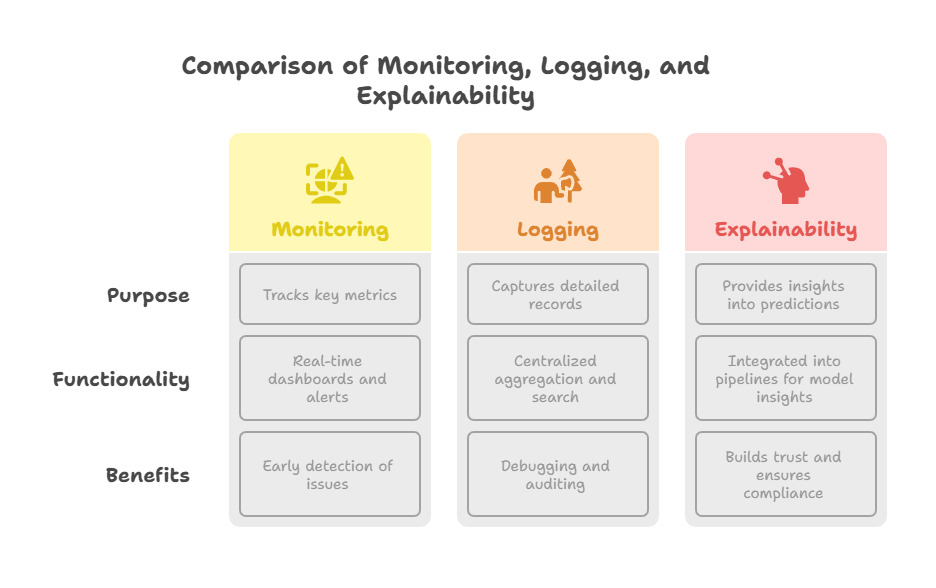
Security, Compliance, and Auditability in ML Monitoring
Security, compliance, and auditability are foundational elements of effective machine learning monitoring, especially in enterprise environments where data privacy and regulatory requirements are paramount. As ML models increasingly influence critical business decisions, ensuring that monitoring systems uphold these principles is essential for maintaining trust and mitigating risk.
Security in ML Monitoring
Protecting sensitive data and model information is crucial. Monitoring systems must implement strong access controls, including role-based access control (RBAC) and integration with enterprise identity providers (e.g., LDAP, SSO). Data and logs should be encrypted both at rest and in transit to prevent unauthorized access. Additionally, secure APIs and network configurations help safeguard monitoring infrastructure from external threats.
Compliance Requirements
Regulations such as GDPR, HIPAA, and CCPA impose strict rules on data handling, user consent, and transparency. Monitoring systems must support compliance by maintaining detailed audit trails of data usage, model predictions, and access logs. Automated compliance checks can validate that models and data pipelines adhere to legal standards before and after deployment.
Auditability and Transparency
Comprehensive audit logs record every action taken within the monitoring system—who accessed data, when models were updated, and how alerts were handled. This transparency is vital for internal governance and external audits. Explainability tools integrated into monitoring provide insights into model decisions, helping demonstrate fairness and accountability.
Best Practices
Enforce strict access controls and authentication mechanisms.
Encrypt all monitoring data and communications.
Maintain immutable, tamper-proof audit logs.
Automate compliance validation within CI/CD and monitoring workflows.
Regularly review security policies and audit logs for anomalies.
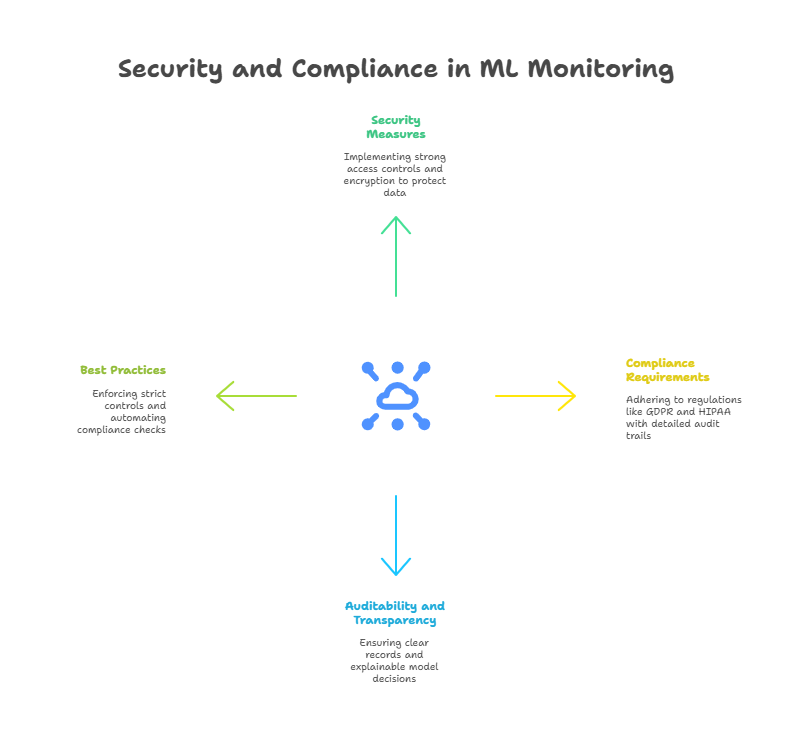
Case Studies: Successful Integration of Data Engineering and MLOps
The successful integration of data engineering and MLOps is a critical factor in delivering scalable, reliable, and efficient AI solutions. Real-world case studies demonstrate how organizations have bridged these disciplines to streamline workflows, improve model quality, and accelerate time-to-market.
Case Study 1: Global E-commerce Platform
A global e-commerce company faced challenges managing vast amounts of customer data and deploying personalized recommendation models. By integrating their data engineering pipelines with MLOps workflows using Apache Airflow and MLflow, they automated data validation, feature engineering, model training, and deployment. This unified approach reduced manual errors, improved model accuracy, and shortened deployment cycles from weeks to days.
Case Study 2: Financial Services Firm
A financial institution needed to comply with stringent regulatory requirements while deploying credit risk models. They implemented a hybrid architecture combining on-premises data processing with cloud-based MLOps tools. Data engineers ensured data quality and lineage using DataOps practices, while MLOps teams managed model versioning, automated testing, and monitoring. This collaboration enabled rapid model updates with full auditability and compliance.
Case Study 3: Healthcare Analytics Company
A healthcare analytics startup integrated data engineering and MLOps to deliver predictive models for patient outcomes. Using feature stores and automated pipelines, they ensured consistent feature availability for training and inference. Continuous monitoring and automated retraining workflows maintained model performance despite evolving clinical data. The integrated approach enhanced patient care and operational efficiency.
Lessons Learned
Automation is key: Automate data and model workflows to reduce errors and accelerate delivery.
Centralize metadata: Unified tracking of data and model lineage supports reproducibility and compliance.
Foster collaboration: Cross-functional teams improve alignment and problem-solving.
Monitor continuously: Integrated monitoring detects issues early and triggers automated responses.
Monitoring ML models in production: tools, challenges, and best practices
MLOps in Practice: Automation and Scaling of the Machine Learning Lifecycle
